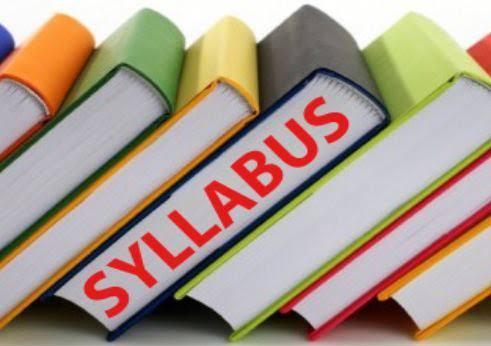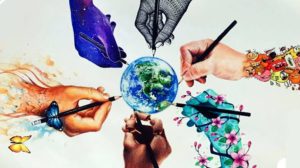Latest Update On Fine Art jamb syllabus: This page will discuss about the Jamb syllabus and recommended textbooks for fine Art for preparation of forthcoming exams joint admissions and Matriculation Board popularly known as (JAMB)
Jamb syllabus for Fine Art – We have uploaded the Joint Admissions and Matriculation Board (JAMB) syllabus in Art for Unified Tertiary Matriculation Examination (UTME) candidates to prepare well for their forthcoming exams.
GENERAL OBJECTIVES
The aim of the Unified Tertiary Matriculation Examination (UTME) syllabus in Art is to prepare the candidates for the Board’s examination. It is designed to test their achievement of the course objectives, which are to:
(i). exhibit knowledge of the fundamental elements, principles and terminologies of art;
(ii). show knowledge of historical dimensions of art with emphasis on Nigerian arts and crafts;
(iii). demonstrate knowledge of artistic techniques, processes, the use of materials and maintenance of tools and equipment;
(iv). display aesthetic awareness of the environment, meaning and functions of art in society.
Recommended Links
UTME Jamb Syllabus For Use Of ENGLISH + Free PDF File
UTME Jamb Syllabus For MUSIC + Free PDF File
UTME Jamb Syllabus For GEOGRAPHY + Free PDF File
UTME Jamb Syllabus For IGBO + Free PDF File
UTME Jamb Syllabus For GOVERNMENT + Free PDF File
UTME Jamb Syllabus For ARABIC + Free PDF File
UTME Jamb Syllabus For HISTORY + Free PDF File
UTME Jamb Syllabus For YORUBA + Free PDF File
UTME Jamb Syllabus For LITERATUREIN ENGLISH + Free PDF File
UTME Jamb Syllabus For BIOLOGY + Free PDF File
UTME Jamb Syllabus For All Other COURSES + Free PDF File
Below are some of the benefits you will derive from having the JAMB fine Art syllabus:
- Getting the fine Art syllabus will enable you know the topics you need to prepare for.
- You will get to know what you’re expected to know from each of the topic.
- The recommended texts section also outline the list of Art books (titles, authors, and editions) you can read.
SECTION A
1. CLASSIFICATION OF ART:
Topics
a. Visual Arts: (Fine and Applied Arts)
b. Performing Arts: (Music, Dance and Drama)
c. Literary Arts: (Poetry, Prose, Recitals) etc.
OBJECTIVES
Candidates should be able to:
i. differentiate between the three branches of art;
2. ELEMENTS AND PRINCIPLES OF DESIGN:
Topics
a. Elements: line, colour, shape, form, texture, tone, value, space etc.
b. Principles: balance, rhythm, proportion, harmony, contrast, repetition, dominance, variety, etc.
OBJECTIVES
Candidates should be able to:
i. identify the elements of design;
ii. analyze the principles of design;
3. ART TERMS:
Pigments, motif, greenware, armature, silhouette, chiaroscuro, cireperdue, terracotta etc.
OBJECTIVES
Candidates should be able to:
i. identify art terms;
ii. link the terms to their areas of art;
iii. use the terms in analyzing artworks
SECTION B
1. HISTORICAL DIMENSIONS OF ART:
Topics;
a. Prehistoric, Greek and Roman Art;
b. Medieval Art: architecture, surface decorations and calligraphy;
c. Renaissance Art and Artists: Giotto Di Bondone, Michelangelo Buonarroti, Leonardo da Vinci and Raphael (Raffaello Santi);
d. 19th and 20th Century art movements; Impressionism, Realism, Futurism, Cubism, Bauhaus, Pop art, Abstract Expressionism and Fauvism.
OBJECTIVES
Candidates should be able to:
i. compare their materials, styles and techniques;
ii. classify the periods and styles with emphasis on architecture, surface decoration and calligraphy;
iii. compare the artists, their works and styles;
iv. differentiate between the various art movements; v.
v. analyze their styles techniques, innovations and influences;
2. TRADITIONAL AFRICAN ART:
Egypt, Ashanti, Dogon, Mossi, Fon, Senufo, Bambara, Mende, Kissi, Bamileke and Bakumba.
OBJECTIVES
Candidates should be able to:
i. categorize works in terms of style, materials and locations;
ii. categorize works in terms of styles, materials and locations;
3. TRADITIONAL NIGERIAN ART:
Topics
Nok, Igbo-Ukwu, Ife, Benin, Esie, Igala, Jukun, Akwashi, and Mbari
OBJECTIVES
Candidates should be able to:
i. analyze the works in terms of functions, characteristics and locations;
4. NIGERIAN CRAFTS:
Topics
Pottery, woodworks, cloth-weaving, carving, leather works, metal works, beadworks, body decoration, mat and cane weaving.
OBJECTIVES
Candidates should be able to:
i. trace the origins, locations and styles;
5. DEVELOPMENT IN CONTEMPORARY NIGERIAN ARTS AND ARTISTS:
Topics
a. Art Schools: Zaria, Nsukka, Osogbo group etc.
b. Nigerian artists and art educators; Aina Onabolu, Ben Enwonwu, S. I. Wangboje, Jimoh Akolo, Dele Jegede etc.
c. Museums, galleries and art centres;
d. Art institutions, cultural art centres, national art organizations – Nigerian Society for Education through Arts (NSEA), Society for Nigerian Artists (S.N.A), National Council for Arts and Culture (N.C.A.C), etc.
e. Major Festivals: Argungu Fishing Festival, Eyo, Egungun, Iri-ji (New Yam), Durbar, Igue, Ekpo, Odo, etc.
OBJECTIVES
Candidates should be able to:
i. determine the influence of the art schools and groups;
ii. assess the artists in terms of their works, specializations, techniques and styles;
ii. analyze the functions of museums, galleries, art centres and art institutions;
iii. evaluate their impact on the development of art;
iv. assess their roles and functions;
v. examine the impact of major festivals on art and culture.
SECTION C
1. ARTISTIC SKILLS, TECHNIQUES AND PROCESSES
Topics
a. Two-Dimensional Art: drawing, painting, graphics and textile design.
b. Perspective:
i. Linear, angular, aerial, parallel etc.
ii. Perspective terms: foreground, picture plane, eye-level, vanishing point, foreshortening, optical illusion, depth etc.
c. Sculpture, Ceramics and Crafts,
d. Computer Graphics: CorelDraw
OBJECTIVES
Candidates should be conversant with:
i. the techniques, skills and processes with emphasis on tone, composition and colour application;
ii. the types of perspective;
iii. the use of perspective rules and terms;
iv. techniques, skills and processes;
v. the basic tools of designs
2. TOOLS, MATERIALS AND EQUIPMENT
Topics;
a. Two-Dimensional Art Tools: brushes, lino cutters, drawing instruments, calligraphic pens, sharpeners etc.
b. Two-dimensional Art Materials: pencils charcoal, pastel, crayon, fixative, fabric, dyes, lino, wood blocks etc.
c. Two-Dimensional Art Equipment: air compressor, spray gun, enlarger, computer etc.
d. Improvisation of tools, materials and equipment;
i. Two-Dimensional Art: colours, brushes, calligraphic pens etc.
ii. Three-Dimensional Art: spatula, kiln, beater, etc.
OBJECTIVES
Candidates should be able to:
i. maintain tools and art materials;
ii. use art materials and tools;
iii. operate and maintain art equipment;
ix. improvise alternatives
SECTION D
1. ART APPRECIATION
Topics
a. Man-made objects: architecture, sculpture etc.
b. Natural phenomena: Zuma Rock, Ikogosi Warm Springs, etc
OBJECTIVES
Candidates should be able to:
i. appreciate the aesthetic qualities of natural and man-made aesthetic phenomena in Nigerian environment;
ii. differentiate between natural and man-made aesthetic phenomena;
2. MEANING AND FUNCTIONS OF ART IN SOCIETY
Topics
a. Meaning of art;
b. Functions of art in the society: religious, social, cultural, political, therapeutic and economic needs.
c. Functions of art in the media: advertisement, education, recreation etc.
OBJECTIVES
Candidates should be able to:
i. examine the meaning and functions of art;
ii. use art to enhance societal values;
iii. assess the role of art in the media;
3. ART ENTREPRENEURSHIP
Topics
Job prospects in Visual Arts: Ceramist, Curator, Textile designer, Industrial designer, Sculptor, Photographer, Cartoonist, Illustrator etc.
OBJECTIVES
Candidates should be able to:
i. identify job opportunities in visual arts
If there is changes on Jamb syllabus for Fine Art 2025/2026 we’d let you know.
Read Also:
Jamb Direct Entry Registration Form [Instructions & Guidelines]
Jamb Subject Combination For All Courses (Science and Art)
JAMB Offices in 36 states of Nigeria [ADDRESS And Contact Details]
Jamb UTME Registration Form [Instructions & Guidelines]
RECOMMENDED TEXTBOOKS FOR FINE ART
Banjoko I. (2000) Visual Arts made Easy: Textbook for Schools and Colleges, Lagos, Movic Publishing Company Ltd.
Egonwa, O.D. (1991) African Art: A contemporary Source Book, Benin: Osasu Publishers.
Egunlae, S.A. (1985) The Essential Ground work in Art and Design, Omotola Standard Press and Bookshop (Nig) Ltd.
Erese, U. O. and Ogunsina E. D. (1989) Creative Arts and Crafts for J. S. S. Onibonoje Press.
Nahab, S. J. (2003) Art of the Millennium for Senior Secondary Schools, Ehindero (Nig.) Ltd.
Ogumor, E. (1993) Certificate Art for Junior Secondary Schools and Senior Secondary Schools, Ibadan: University Press Plc.
Olaosebikan W. A. (1982) Cultural and Creative Arts,Evans.
Olurukooba, B. K. (1991) Art for Senior Secondary Schools, ABU.
Uzoagba I. N. (1982) Understanding Art in General Education, Onitsha; African Publishing Ltd.
Wangboje, I. N. (1982) A Textbook on Art for Junior and Senior Secondary Schools, Evans Publishers.
We advise you to bookmark this page and always check here for more guideline and updates.
Download Jamb Syllabus For Fine Art In PDF File Format
Follow the link below to download Jamb syllabus for fine Art PDF file for free (Note: You will however need a device that is capable of opening PDF files to access the list).
This is the latest Jamb syllabus and recommended textbooks for fine Art for preparation of forthcoming exams this article will always be updated when an update arises.
Feel free to share this amazing post with your family and friends.

